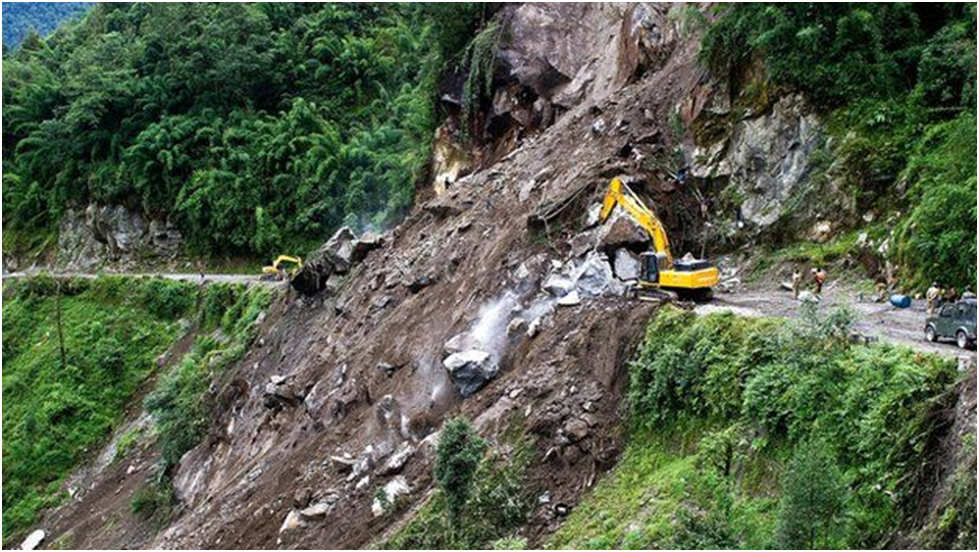QUES . Landslide is a major problem in the Himalayan region. Discuss its causes and mitigation measures.
HINTS:

Must read: High-altitude environmental hazards
There are two regions in India which are most vulnerable to landslides – the Himalayas and the Western Ghats. Compared to Western Ghats region, the slides in the Himalayas region are huge and massive and in most cases the overburden along with the underlying rocks is displaced during sliding particularly due to the seismic factor.
Uttarakhand and Himachal Pradesh in the Himalayan region are extremely eco-sensitive. The latter is very vulnerable to natural calamities and every year, hundreds of people lose their lives due to landslides along with destruction worth crores of rupees.
Cause of Landslides in the Himalayan region
There are two major causes:
Natural causes
֍ The Himalayan region is a tectonic active region and thus unstable, as it is a continental-continental convergence zone (of the Indian Plate and the Eurasian plate). The Indian plate is still moving in the northeastern direction and due to the same, stress is generated in the rocks. Himalayan peaks are still rising, hence Himalayan region is prone to earthquake and landslide disasters.
֍ The slope of the southern side of the Himalayan ranges is steep as compared to the northern side. Heavy rainfall and snowfall on these steeper slopes causes landslides in the region.
֍ The Himalayan region is mostly made up of sedimentary rocks which make the region weak, as a result, it causes landslides. Some of the Himalayan rocks are made of limestone, which is more prone to water and landslides than other types of rocks because it can dissolve in weakly acidic rainwater or groundwater. This process creates caves, sinkholes, and other karst features that weaken the stability of the slopes.
֍ Climate-induced excessive events like freezing/thawing and heavy rain/snow precipitation lead to landslides. Confluence of Westerly Disturbance and the South West Indian Summer Monsoon cause excessive and concentrated rainfall in parts of J&K, Himachal Pradesh and Uttarakhand leading to landslides and flash floods.
Human-induced causes
֍ Water impoundment and leakage from utilities. For example from hydropower projects, lack of proper sewerage system in hilly areas.
֍ Mining activities and excavation (particularly at the toe of slope)
֍ Artificial vibrations
֍ Deforestation
֍ Jhum Cultivation
֍ Construction activities (Road, highways, dam,tunneling, etc)
֍ Industrial activities
The 2013 Kedarnath Tragedy was also influenced by the unplanned development and construction activities in the area, such as hotels, roads, bridges, and dams, that had altered the natural drainage system and increased the soil erosion.
Mitigation measures of landslides in the Himalayan region
We can not control the natural cause of landslides but definitely, we can minimize the impact of landslides on humans by strengthening our knowledge about the pattern and timing of landslides.
֍ The most important triggering mechanism for mass movements is the water infiltrating into the overburden during heavy rains and consequent increase in pore pressure within the overburden. When this happens in steep slopes the safety factor of the slope material gets considerably reduced causing it to move down. Hence the natural way of preventing this situation is by reducing infiltration and allowing excess water to move down without hindrance. As such, the first and foremost mitigation measure is drainage correction. This involves maintenance of natural drainage channels both micro and macro in vulnerable slopes.
֍ The universal use of contour bounding for all types of terrain without consideration of the slope, overburden thickness and texture or drainage set- up needs to be controlled.
֍ Leaving aside the ‘critical zones’ with settlements could be avoided altogether and which could be preferably used for permanent vegetation, the ‘highly unstable zones’ generally lie in the upper regions, which are occupied by highly degraded vegetation. These areas warrant immediate afforestation measures with suitable plant species.
֍ We can also prevent human-induced landslides through slope management, proper land use measures and spreading awareness.
֍ Preparation and monitoring of early warning systems, creation of user-friendly landslide hazard maps, etc.
